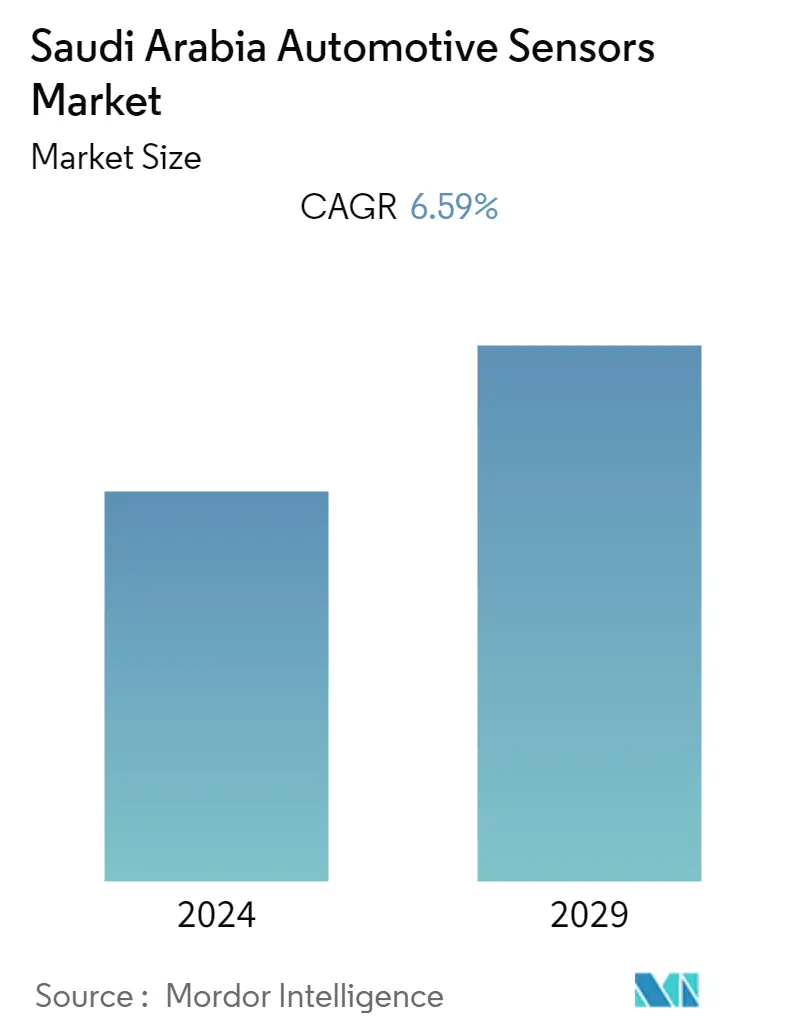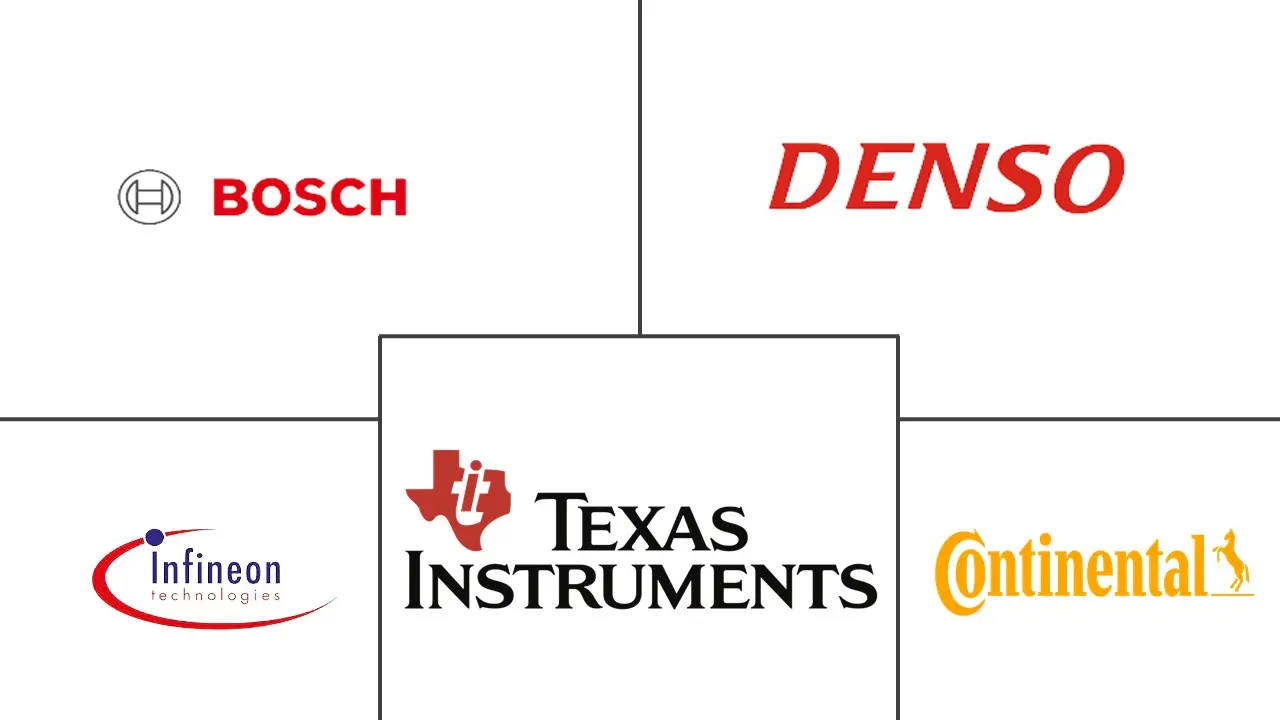Market Size of Saudi Arabia Automotive Sensors Industry

| Study Period | 2019 - 2029 |
| Base Year For Estimation | 2023 |
| Forecast Data Period | 2024 - 2029 |
| Historical Data Period | 2019 - 2022 |
| CAGR | 6.59 % |
| Market Concentration | Medium |
Major Players
*Disclaimer: Major Players sorted in no particular order |
Saudi Arabia Automotive Sensors Market Analysis
The Saudi Arabia Automotive Senors market was valued at USD 387.2 Million in 2021. It is expected to reach USD 532.8 Million by 2027, registering a CAGR of around 6.59% during the forecast period (2022-2027).
The COVID-19 outbreak and propagation had a detrimental impact on the automotive sensors industry in 2020, resulting in lower demand for car sensors. As a result, the revenues earned by them decreased. As a result, the market's growth trajectory has slowed during the first half of 2020. This pattern maintained until the first quarter of 2021. The rise in manufacturing volume of passenger cars and hybrid electric vehicles is observed in the country after the pandemic due to the easing of restrictions in the country, the market will cope with all the losses that happen during the period and will grow at a certain pace.
Over the long-term, the Saudi Arabia automotive sensors market is expected to expand rapidly owing to the key factors such as rising demand for vehicle safety and a shift in customer preference toward alternative fuel cars. Furthermore, continued sensor technology advancements and the rising usage of autonomous cars are likely to generate enormous potential prospects for the Saudi Arabia automotive sensors market over the next five years.
The Saudi Guidelines, Metrology, and Quality Organization (SASO) has published standards requiring automotive manufacturers to rigorously adhere to safety norms for new vehicles. The new standards should follow the criteria outlined in technical regulation sector 42 under the specific requirements for automotive manufacturing. Under the proposed method, automobile industry participants must also work on developing electronic components, safety sensors, smart braking systems, and other safety features. The increased emphasis of major authorities on increasing car safety is predicted to fuel the growth of the Saudi Arabia automotive sensors market by 2027.
Several automotive sensors, including engine speed, temperature, vehicle speed, throttle position, and others, are used in electric cars. With the expansion of the electric car sector, the Saudi Arabia automotive sensors market is likely to rise significantly over the forecast period.
Saudi Arabia Automotive Sensors Industry Segmentation
A sensor is an electrical device that aids in the detection and response to some type of input from the physical situation. The specific data might contain any type of information such as moisture, weight, or light, among many other environmental occurrences. In general, the output is a signal that is transformed into a human-readable display at the sensor site or electronically transferred via a network for reading or additional processing.
Saudi Arabia's Automotive Sensors Market is segmented into sensor type, vehicle type, application type, and technology type.
By Sensor Type, the market is segmented into temperature sensor, pressure sensor, oxygen sensor, position sensor, motion Sensor, torque sensor, optical sensor, and others.
By Vehicle Type, the market segment is bifurcated into passenger cars and commercial vehicles.
By Application, the market segment is divided into ADAS, chassis, powertrain, and others.
By Technology, the market is segmented into MEMS and Non-MEMS.
The report also provides market sizing and forecast for all the above-mentioned segments.
Saudi Arabia Automotive Sensors Market Size Summary
The Saudi Arabia automotive sensors market is poised for significant growth, driven by increasing demand for vehicle safety and a shift towards alternative fuel vehicles. The market is recovering from the setbacks caused by the COVID-19 pandemic, with a resurgence in the manufacturing of passenger cars and hybrid electric vehicles. The government's focus on enhancing vehicle safety standards, as mandated by the Saudi Guidelines, Metrology, and Quality Organization (SASO), is expected to further propel the market. Additionally, advancements in sensor technology and the rising adoption of autonomous vehicles are creating substantial opportunities for market expansion. The integration of advanced driver assistance systems (ADAS) and the growing electric vehicle sector are also contributing to the market's positive outlook.
Saudi Arabia's economic growth, fueled by high individual income levels and a robust financial sector, is boosting the demand for luxury goods, including automobiles. The government's Vision 2030 initiative aims to increase the production of vehicles, including electric cars, with significant investments in infrastructure and partnerships with global automotive players. The establishment of economic towns and the recruitment of original equipment manufacturers (OEMs) are expected to diversify the economy and enhance the automotive ecosystem. The presence of major players like Robert Bosch GmbH, Denso Corporation, and Texas Instruments Incorporated in the region underscores the market's moderate consolidation. These developments, coupled with international companies entering the market, are anticipated to drive the growth of automotive sensors in Saudi Arabia over the forecast period.
Saudi Arabia Automotive Sensors Market Size - Table of Contents
-
1. MARKET DYNAMICS
-
1.1 Market Overview
-
1.2 Market Drivers
-
1.3 Market Restraints
-
1.4 Value Chain / Supply Chain Analysis
-
1.5 Porters 5 Force Analysis
-
1.5.1 Threat of New Entrants
-
1.5.2 Bargaining Power of Buyers/Consumers
-
1.5.3 Bargaining Power of Suppliers
-
1.5.4 Threat of Substitute Products
-
1.5.5 Intensity of Competitive Rivalry
-
-
-
2. MARKET SEGMENTATION (Value in USD Billion)
-
2.1 Sensor Type
-
2.1.1 Temperature Sensor
-
2.1.2 Pressure Sensor
-
2.1.3 Oxygen Sensor
-
2.1.4 Position Sensor
-
2.1.5 Motion Sensor
-
2.1.6 Torque Sensor
-
2.1.7 Optical Sensor
-
2.1.8 Others
-
-
2.2 Vehicle Type
-
2.2.1 Passenger Cars
-
2.2.2 Commercial Vehicles
-
-
2.3 Application
-
2.3.1 ADAS
-
2.3.2 Chassis
-
2.3.3 Power Train
-
2.3.4 Others
-
-
2.4 Technology
-
2.4.1 MEMS
-
2.4.2 Non-MEMS
-
-
Saudi Arabia Automotive Sensors Market Size FAQs
What is the current Saudi Arabia Automotive Sensors Market size?
The Saudi Arabia Automotive Sensors Market is projected to register a CAGR of 6.59% during the forecast period (2024-2029)
Who are the key players in Saudi Arabia Automotive Sensors Market?
Robert Bosch GmbH, Denso Corporation, Infineon Technologies AG , Texas Instruments Incorporated and Continental AG are the major companies operating in the Saudi Arabia Automotive Sensors Market.

